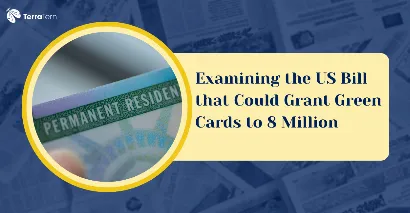Key Highlights
The United States immigration system, which has been variously cited as complex and outdated, is again on the legislative agenda. Another huge and new bill that has been introduced in the U.S. Congress wants to grant immigrants (and it is estimated that 8 million of them are around) a pathway to a legal permanent resident status, which is also known as a green card. This is an ambitious plan to revise a law that is a few decades old to possibly change the lives of millions of people who have been part of American society for a long time without full legal status. Introduced by Senator Alex Padilla, the bill is a fresh attempt to solve chronic problems in the immigration system and set an example of hope to millions of immigrants who are living and developing their lives in the United States but cannot obtain legal status.
The possibility of such drastic innovation is, of course, not without its sceptics: How does this proposed legislation look? To whom is it of the most benefit? And, most importantly of all, what is its likelihood of getting through the bad waters of congressional politics? In addressing the questions, the answers will help millions of people and the future course of the US's approach to immigration.
The "Registry" Provision: Updating an Antiquated System
The most important part of this new bill is an amendment to Section 249 of the Immigration and Nationality Act. This last one is commonly known as the Registry, and it enables the residents who are not citizens to provide an application to become permanent residents in case they have continuously lived in the U.S. over a given period. The practical basis of Registry provisions is to provide individuals a means of attaining legal status in the country who have maintained a long-term desire to remain in the country, irrespective of being brought into the country without authorization or visa overstaying. It recognises that a substantial period has passed during which numerous such people have become highly embedded in American communities and households, as well as the economy.
But the present version of Registry is a very dated one. The date, which it has set as its cutoff date, January 1, 1972, makes it of little use to today's undocumented people or long-term visa holders, to an overwhelming majority of them. Thus, to get the status under the current law, one will have to demonstrate that he or she has been a constant resident of the U.S. since at least 1972, since which fewer and fewer people will be able to do each year. Such an outdated cutoff has been a focus of dispute by immigration activists who believe that it does not represent the actualities of present-day immigration and the requirements of a modern-day, varied workforce and society.
Also Read: US Immigration: Everything You Should Know Is Here
The Proposed Amendment: A Commonsense Fix?
Senator Padilla has taken this anachronism head-on with a bill that has a very important alteration to make on the cutoff date. The amendment would allow those who have been living in the U.S. uninterrupted within the last seven years and who submit an application for the Green Card to qualify as a lawful permanent resident. This is a crucial change in the seven-year rolling residency to a fixed date of entry. It would modernise the Registry and make it a living instrument that can bring relief to millions of current immigrants.
Senator Padilla positioned this suggested reform as a commonsense solution to a pathologically broken immigration system. His reasoning revolves around the notion that an immigration system ought to evolve with time and recognise the input of people who passed away a long time ago, but they are still part of the fabric of the nation. The bill is expected to bring these individuals out of the shadows, give them more stability, and allow them to contribute even more to American society by simply permitting people who took deep roots here in the U.S. to regularise their status. This issue is rather practical, trying to simplify procedures and provide a compassionate solution to the illegal status of a significant part of the immigrant community.
Also Read: US Visitor Visa B1/B2
Who Stands to Benefit: A Diverse Cohort of Contributors
If enacted, this legislation would have a profound impact on a broad spectrum of immigrant communities. The estimated 8 million beneficiaries represent a diverse group, each facing unique challenges within the current immigration system.
Dreamers and Temporary Protected Status Holders
One of the most well-known communities that will receive the benefit is Dreamers, or young undocumented immigrants who were moved to the U.S. as children. A good number of them have been brought up in the U.S., have also attended the schools of the U.S, and they have never known the other home (U.S) to be a foreign place. No matter how integrated they are with the country, they still lack consistent legal status, which makes it impossible for them to enjoy the full benefits of education and career mobility. The bill would give them the permanent answer to their long-time limbo, the security and the stability they need to flourish. In the same vein, Deferred Action childhood arrivals (DACA) and Temporary Protected Status (TPS) recipients, who are allowed to temporarily reside in the U.S after rising in situations of armed disturbance or natural disasters in their countries of origin, might get to possess a reasonable course of action to stay in America permanently once and, for all, dragging years of anxiety as to whether or not their situation could expire to an end.
Essential Workers and Highly Skilled Professionals
A greater number of the potential advantages of the bill can also be tested by essential workers who have been seen to engage in important capacities especially when the country is faced with a national crisis, such as the recent case of the pandemic, and working in some incredibly important sectors of the sector including the medical sector, crop cultivation, and service providers. Such people who had spent years residing and working in the U.S. were finally able to get their legal status reflective of their vital roles.
Most importantly, the law has huge repercussions on highly talented people, who happen to be holders of H-1B visas, many of them being Indian citizens. Such professionals usually have to wait long periods in order to access employment-based Green Cards, such that they are virtually stuck in temporary visas, where there is no immediately apparent way to permanent residence. The suggested amendment may help to avoid such long queues, providing a shortcut to the Green Cards of those people who have been investing their skills and expertise in the American economy for several years. That would solve one of the prime irritants of most technology and medical personnel, who are brought in because of a key labour gap, only to face the barrier to long-term settlement that can be found in most bureaucracies.
Protecting Children from "Ageing Out"
The other dire area on how the bill would have impinged is the fact that it would safeguard children who are facing the menace of ageing out or out of the position of dependent visas. Children of those having long-term visitor visas (e.g., H-1B, L-1, or E-2 visa) are generally treated as dependents until the age of 21 under the existing immigration law. At this age, in case their parents still had not obtained the Green Card, these young adults can age out of their status as dependents, essentially losing their rights to stay in the U.S., unless they manage to access a different type of visa, e.g., an international student visa, or leave the country. This more often than not compels highly educated and raised Americans to leave, even though they are very assimilated into American society. The Registry bill, with its expanded access to permanent residency based on long-term residence, would be the solution to this heartbreaking consequence on so many family units and would enable the continuance of the life and career of these young people in the country that is their home.
Also Read: Intracompany Transfer Visa USA
The Uphill Battle: Will It Pass?
Although the idea to pass the bill sounds convincing and the effect can be judged as rather positive and large-scale, immigration analysts are very doubtful of the future of the bill. The political realm in the United States, especially the topic of immigration reform, has become infamous due to its extreme nature of polarisation. Overarching immigration reform has also been a difficult issue in Congress over many years, and the cross-party agreement eluded many. The topic can easily turn into a partisan bromide, so any initiative that seems too soft or too radical to both sides of the left and the right is unlikely to get through.
Michelle Cottrell (2022) lists among the issues that put the current bill under a lot of question marks the fact that an identical bill that was proposed by Senator Padilla in September of 2022 failed to pass. That bill, which was meant also to modernise the Registry, failed to gather momentum to the extent that it passed. The fact that a very similar proposal did not advance even a few years earlier underscored the inherent resistance to these measures and that comprehensive immigration reforms are very hard to pass in the current Congress. Unless there is a monumental change in politics or a strong bipartisan momentum, the future of this latest legislation is difficult to fathom.
Challenges and Opposition
Opposition to such a bill usually has its reasons based on concerns. It is also claimed that this would only encourage subsequent illegal immigration, or it is also stated that there are issues with regard to national security, or the impact on the economy of being able to integrate a great number of new Green Card holders. Issues regarding the possibility of strain on the social services and infrastructure also exist. Also, there are still powers that cannot accommodate the idea of giving legal status to people who can be overstaying their visas or illegally entering the country, as it is very much resisted by the members of groups corresponding to strict-enforcers and a merit-based system of immigration.
In the legislative process itself, great barriers are thrown. And although it is a possibility that the bill passes the Senate, it would also have to pass through the House of Representatives, which may prove even more divided into political factions. Gaining the requisite votes on both sides of the aisle and even more so, should a super majority be needed to keep off a filibuster in the Senate, will hence require a LOT of negotiation, compromise, and bipartisan cooperation that has been hard to come by on matters of immigration.
Broader Implications and the Path Forward
The broader consequences of enacting such a bill on the United States may be far-reaching if the bill is passed. Formalising the situation with a large number of immigrants would open the way to a significant economic advantage. Legal immigrants are better able to get better wages, contribute more taxes, establish businesses, and invest in their neighbourhoods. Such formal inclusion might increase consumer expenditure, grow the tax base, and improve the economy. In addition, it would enable millions of people to work fearlessly, seek better employment opportunities, and contribute to the economy to a larger extent, leaving behind the informal labour market.
On the social front, acceptance of these people into the main society would enhance society. Families would become stable, which would lead to the mitigation of stress and the overall improvement of welfare. It might potentially create a more unified society as it would destroy the divide between the documented and undocumented people, bringing in an understanding of the sense of belonging and civic engagement to those who have been living in the darkness.
The Ongoing Immigration Debate
The other controversy, which is once again resurrected by the bill, is regarding the comprehensive immigration reform that has been going on all these years. Its introduction can be accepted to remind us of how poorly the details of the U.S. immigration system should be addressed, with the majority of them agreeing that it has to be thoroughly updated. One way or another, that specific piece of legislation is bound to add to the flames of the discussion of the policies of the U.S. in relation to its borders, to its immigrant acceptance, and to the whole integration of new people into the U.S. culture. It has forced policymakers and the rest of the population to confront the reality of a large and established immigrant population that is currently stateless.
Conclusion: A Test of Political Will
The present situation of the green card bill, planned to provide Green Cards to the 8 million immigrants through the modernisation of the outdated Registry provision, marks the most important step in the continuing debate about the issue of immigration. It provides a physical avenue to security and access to Dreamers, key practitioners, highly skilled workers, and households throughout the country. The possible rewards, both economically and socially, are obvious, but the political obstacles are still extremely tall.
The final step of the bill will act as a serious determination of political resolution, and flexibility within a seriously divided Congress. It is yet to be seen whether this commonly sense solution would break partisan gridlock and change the lives of millions of people. The thing is, though, that no one can deny that such an immigration system that is modern, humane, and efficient is needed now more than ever, and this bill places this all-important debate again in the spotlight. To learn more about the latest US bills, contact TerraTern right away!








